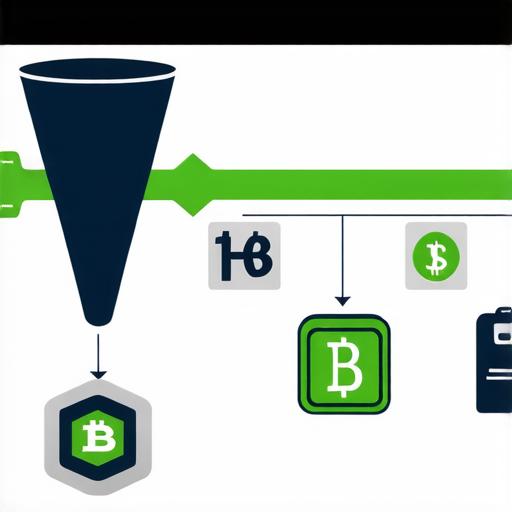Introduction
As cryptocurrencies become increasingly popular, many people are turning to them as an alternative form of currency. However, one of the challenges faced by crypto enthusiasts is transferring their cryptocurrency holdings to traditional bank accounts. In this article, we will explore the different methods available for transferring cryptocurrency to a bank account and provide guidance on how to do so safely and efficiently.
The Basics of Transferring Cryptocurrency
Before we dive into the specifics of transferring cryptocurrency to a bank account, it’s important to understand the basics of how this process works. To transfer cryptocurrency, you will need to have access to both a cryptocurrency wallet and a bank account. Your cryptocurrency wallet is where your digital assets are stored, while your bank account is where you can deposit the funds from your cryptocurrency transaction.
One of the most common ways to transfer cryptocurrency is through an exchange platform. Exchanges allow users to buy, sell, and trade cryptocurrencies, as well as convert them into other forms of currency. To transfer cryptocurrency through an exchange, you will need to create an account with the exchange and link it to your cryptocurrency wallet. From there, you can place a sell order for the cryptocurrency you want to transfer, specifying the amount you want to sell and the currency you want to receive. The exchange will then handle the transaction, transferring the funds from your cryptocurrency wallet to your bank account.
Another method of transferring cryptocurrency is through a direct transfer from one wallet to another. This can be done using a variety of methods, including peer-to-peer transactions and smart contracts.
Factors to Consider When Transferring Cryptocurrency
When transferring cryptocurrency, there are several factors to consider in order to ensure a smooth and successful transaction. These include:
- Fees: Most exchanges and wallets charge fees for transferring cryptocurrency. It’s important to understand these fees before initiating a transfer, as they can eat into your profit margins if not carefully managed.
- Tax implications: Depending on the jurisdiction in which you live, transferring cryptocurrency may have tax implications. It’s important to consult with a tax professional before making any transfers to understand your obligations and how to properly report your transactions.
- Security: Transferring cryptocurrency involves the movement of funds, which makes it vulnerable to theft or hacking. It’s important to use secure wallets and exchanges, and to take steps to protect your private keys and other sensitive information.
- Timing: Cryptocurrency markets can be volatile, and the value of your holdings may fluctuate rapidly during the transfer process. It’s important to time your transfers carefully to maximize your profits and minimize your risks.

Methods for Transferring Cryptocurrency to a Bank Account
Now that we have covered the basics of transferring cryptocurrency and the factors to consider when doing so, let’s take a closer look at the different methods available for transferring cryptocurrency to a bank account.
- Exchange Platforms: As mentioned earlier, exchange platforms are one of the most common ways to transfer cryptocurrency. To transfer cryptocurrency through an exchange, you will need to create an account with the exchange and link it to your cryptocurrency wallet. From there, you can place a sell order for the cryptocurrency you want to transfer, specifying the amount you want to sell and the currency you want to receive. The exchange will then handle the transaction, transferring the funds from your cryptocurrency wallet to your bank account.
- Direct Transfers: Direct transfers allow users to transfer cryptocurrency directly between two wallets or through intermediaries such as escrow services. To initiate a direct transfer, you will need to have access to both the sender and receiver wallets, as well as any necessary intermediaries or escrow services.
- Peer-to-Peer Transactions: Peer-to-peer transactions allow users to transfer cryptocurrency directly with other individuals without the need for an intermediary such as an exchange or escrow service. To initiate a peer-to-peer transaction, you will need to find a willing counterparty and negotiate the terms of the transfer.
- Smart Contracts: Smart contracts are self-executing contracts that can be used to automate the transfer of cryptocurrency. They can be programmed to execute automatically once certain conditions are met, such as the receipt of a certain amount of cryptocurrency or the fulfillment of a specific obligation. To use smart contracts for transferring cryptocurrency, you will need to have access to a platform that supports smart contract functionality.
FAQs on Transferring Cryptocurrency
Here are some frequently asked questions about transferring cryptocurrency:
1. How long does it take to transfer cryptocurrency?
The time it takes to transfer cryptocurrency can vary depending on the method used and the specific circumstances of the transaction. Exchange platforms typically process transfers within a few hours, while direct transfers and peer-to-peer transactions may take longer. Smart contracts can also take several days or even weeks to execute, depending on the complexity of the contract and the number of parties involved.
2. What are the fees associated with transferring cryptocurrency?
Fees for transferring cryptocurrency vary depending on the method used and the specific circumstances of the transaction. Exchange platforms typically charge a small percentage of the transaction value as a fee, while direct transfers and peer-to-peer transactions may involve additional costs such as escrow fees or intermediary fees. Smart contracts may also involve fees for executing the contract, depending on the terms of the agreement.
3. Can I transfer cryptocurrency to a bank account in another country?
Yes, it is possible to transfer cryptocurrency to a bank account in another country. However, this may involve additional steps such as currency conversion or compliance with local regulations. It’s important to consult with a financial professional before initiating a transfer to another country to ensure that you are in compliance with all applicable laws and regulations.
4. Is it safe to transfer cryptocurrency to a bank account?
While transferring cryptocurrency involves the movement of funds, it is generally safe if you take steps to protect your private keys and other sensitive information. It’s important to use secure wallets and exchanges, and to avoid using public Wi-Fi networks or other unsecured connections when accessing your cryptocurrency holdings.
5. Can I transfer cryptocurrency anonymously?
It is generally not possible to transfer cryptocurrency anonymously, as transactions are recorded on a public ledger known as the blockchain. While it may be possible to use privacy-enhancing technologies such as mixnets or zero-knowledge proofs to obscure the identity of the transaction participants, these methods are not foolproof and may still leave traces that can be traced back to the individual or group making the transfer.
Conclusion
Transferring cryptocurrency to a bank account is a relatively straightforward process that can be done through exchange platforms, direct transfers, peer-to-peer transactions, or smart contracts. However, it’s important to consider the factors involved in the transfer process and take steps to protect your private keys and other sensitive information. With the right knowledge and precautions, you can safely and efficiently transfer your cryptocurrency holdings to a bank account for use in traditional financial systems.
